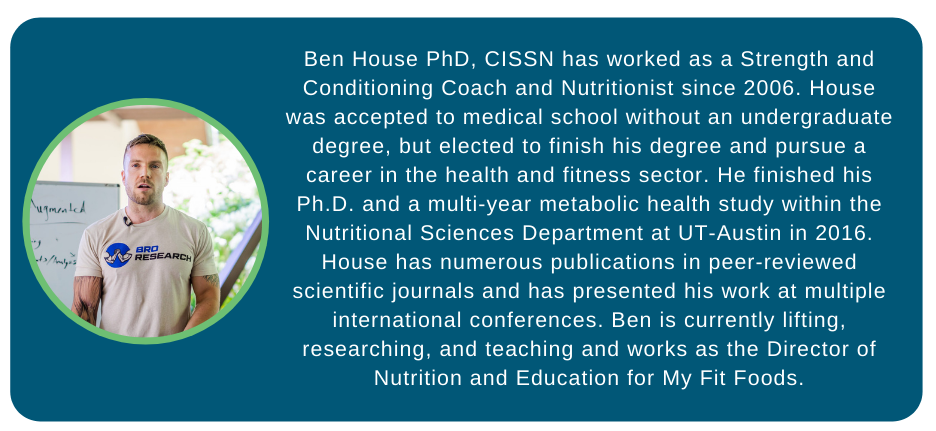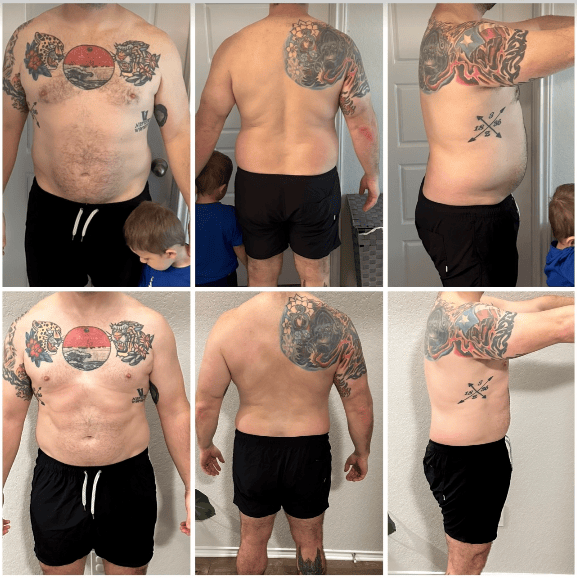Personalized and continuously adjusted goals are huge part of both short-term and long-term success [1] and the entire exploratory process of goal setting can be really helpful!
It is generally going to better if these goals come from within [2, 3], although working with a trained coach can add an element of objective reflection to help us identify our blindspots and feasibility of our goals.
“Self-defined, personalized goals appeared more significant than externally defined goals yet were frequently guided by external input.” -Spreckley et al., 2021 [1]
If goals are so important how can we set better ones that have a greater chance of success and that move us to a place that we really want to go?
1. Never set an Outcome goal without a Process goal.

As a coach this is something that I never back down on. Many times clients will have the goal of losing 30 pounds, but my job as a coach is break this outcome based goal into the most effective feasible processes that are going to move this person towards their outcome goal.
I think of the outcome goal as identifying your destination in the middle of the ocean. If you don’t have a compass, a rudder, and the skills to sail a boat…you aren’t going anywhere.
The other reason I like this shipping analogy is that you are going to encounter storms that are going to throw you off course and then it is your skills, resources, and support network that allow you to get back on your heading towards your intended outcome destination.
Furthermore, even process goals can be broken down into better process goals.
For losing and maintaining weight loss increasing physical activity is probably one of the most important behaviors for both short-term and long-term success [4-6].
When I show people the mind-blowing research on this topic…they will inevitably get excited and say things like, “I can get 10,000 steps!” Please take no offense but I don’t believe them.
In most cases, they shouldn’t believe themselves.
The average American is currently getting between 3 and 5,000 steps per day [7, 8] and increasing that number to 10,000 likely means 50 to 70 more minutes per day of walking. Not many people can whimsically fit an extra hour of movement into their day, and especially so if they have a desk job and other family time commitments.
Therefore, as a coach we have to work together to go through a normal day and normal week to begin to figure out where we could potentially increase activity, because parking further away at the grocery store or taking the stairs every now and again probably isn’t going to get most people to 10,000 steps.
We have to engineer this behavior into their daily life in a personalized way that is feasible long term for them!
This is why creating individualized process goals that align with our outcome goals is number 1 on the list.
“You do not rise to the level of your goals. You fall to the level of your systems.” -James Clear
2. Approach goals are likely more helpful and effective than Avoidance goals.

The nutrition and fitness space is obsessed with Purity or Morality based Avoidance Goals that we can easily flip to far more effective and inclusive Approach goals.
Let’s think of some of the more popular Purity based Avoidance Goals that forever hover around the nutrition space.
Never eat another processed red meat product again or you will burn in an eternal fire of quinoa and tempeh.
Never eat sugar again. Oh and if you do consume any of that luscious white powder…immediate sinful lazy unworthy fatty.
These types of all-or-nothing avoidance goals can be alluring, but don’t think of a Pink Elephant.
100% chance you just thought about a Pink Elephant and for some really weird reason you probably want one.
These types of Rigid and Restrictive goals can work for some people, but they do tend to increase how much we want Pink Elephants, Sugar, or Bacon. Let’s take this to an example.
Never ever eating any processed red meat again maybe might decrease your risk of all-cause mortality (death) by ~10% (perhaps maybe a little higher if we cherry pick data and groups within the data) [9, 10].
That means no bacon, sausage, or hot dogs FOREVER!
Now, thinking back to the example above what is the all-cause mortality risk reduction from going from 2,500 to 10,000 steps per day?
50-60% AKA potentially 500% greater than that other avoidance goal [11].
If you want to stay on just the food side and create a better Approach goal, going from 1 serving of fruits and vegetables to 5 servings per day likely picks you up most of the risk reduction that we see from completely avoiding processed red meat forever [12-15].
Trying to make this same 100% avoidance case with sugar intake is even harder because you probably don’t get a big negative until you get over 10% of the calories coming from added sugar [16-19].
So instead of setting less effective Purity based Avoidance goals that will very likely ultimately result in shame, guilt, and judgement on others try to flip the goal to a more effective Approach goal [2, 20].
3. Strive for Value, Process, and Outcome Alignment.

I have nothing against SMART goals (Specific, Measurable, Attainable, Realistic, and Time-Bound) and I think the framework overall can be really helpful, but it is good to acknowledge that the origin for the this acronym comes from the business world and the A originally stood for Assignable, not Attainable.
Also, some things like happiness and well-being are harder to measure than weight on a scale so many times psychological metrics can be discounted for values that are perhaps more easily measured and quantified.
This is why it is likely more effective to make sure that your outcome and process goals are in alignment with your personal core values [21-25].
For a quick little video on Value-Based Goals click HERE.
Having outcome goals and daily processes that are aligned with our values helps us make sure that we are headed in a direction that we actually want to go and it can also likely help us stay on the path when things get tough.
The other big component of SMART goals that can be helpful to work through is the R or setting Realistic Goals.
As we touched on above many people set an end goal for weight loss. Recent evidence tells us that it is likely better to chunk that goal into smaller pieces.
As coaches we never want to damper anyone’s initial motivation, but we can keep motivation higher by showing continual short-term progress by chunking this end goal into more feasible short-term goals.
Research from behavioral psychology points to the ideology that a good first end goal for those who are living with overweight or obesity is likely 10% weight loss. Then once this number is hit, we can reassess the goal and talk through the processes we would need on board to move this number down further.
Bailey summarizes this ideology well in the quote below [2]. “Setting and achieving challenging goals can enhance self-efficacy, but repeated failure to achieve a goal can result in diminished self-efficacy, decreased satisfaction, and impaired future performance.”
Setting Goals is a pivotal part of the process. When you are setting SMART goals my advice is to make sure you have Value – Process – Outcome alignment.
I would focus on Approach goals over Avoidance goals and we generally want to chunk long-term goals into realistic and trackable short-term goals.
Another really helpful activity to couple with goal setting is defining your most likely Obstacles and then create personalized Implementation Intentions to get around them! We cover this aspect of goal setting HERE.
Thank You For Reading and we wish you the absolute best as you chase down those goals!
#GIVEAFIT

REFERENCES:
1. Spreckley, M., J. Seidell, and J. Halberstadt, Perspectives into the experience of successful, substantial long-term weight-loss maintenance: a systematic review. Int J Qual Stud Health Well-being, 2021. 16(1): p. 1862481.
2. Bailey, R.R., Goal Setting and Action Planning for Health Behavior Change. Am J Lifestyle Med, 2019. 13(6): p. 615-618.
3. Samdal, G.B., et al., Effective behaviour change techniques for physical activity and healthy eating in overweight and obese adults; systematic review and meta-regression analyses. Int J Behav Nutr Phys Act, 2017. 14(1): p. 42.
4. Church, T.S. and C.K. Martin, Exercise is the Key to Keeping Weight Off, but What is the Key to Consistently Exercising? Obesity (Silver Spring), 2019. 27(3): p. 361.
5. Ostendorf, D.M., et al., Physical Activity Energy Expenditure and Total Daily Energy Expenditure in Successful Weight Loss Maintainers. Obesity (Silver Spring), 2019. 27(3): p. 496-504.
6. Melby, C.L., et al., Increasing Energy Flux to Maintain Diet-Induced Weight Loss. Nutrients, 2019. 11(10).
7. Bassett, D.R., Jr., et al., Pedometer-measured physical activity and health behaviors in U.S. adults. Med Sci Sports Exerc, 2010. 42(10): p. 1819-25.
8. Lawhun Costello, V., et al., Impact of the COVID-19 Pandemic on Objectively Measured Physical Activity and Sedentary Behavior Among Overweight Young Adults: Yearlong Longitudinal Analysis. JMIR Public Health Surveill, 2021. 7(11): p. e28317.
9. Zhong, V.W., et al., Associations of Processed Meat, Unprocessed Red Meat, Poultry, or Fish Intake With Incident Cardiovascular Disease and All-Cause Mortality. JAMA Intern Med, 2020. 180(4): p. 503-512.
10. Larsson, S.C. and N. Orsini, Red meat and processed meat consumption and all-cause mortality: a meta-analysis. Am J Epidemiol, 2014. 179(3): p. 282-9.
11. Jayedi, A., A. Gohari, and S. Shab-Bidar, Daily Step Count and All-Cause Mortality: A Dose-Response Meta-analysis of Prospective Cohort Studies. Sports Med, 2021.
12. Bellavia, A., F. Stilling, and A. Wolk, High red meat intake and all-cause cardiovascular and cancer mortality: is the risk modified by fruit and vegetable intake? Am J Clin Nutr, 2016. 104(4): p. 1137-1143.
13. Bellavia, A., et al., Fruit and vegetable consumption and all-cause mortality: a dose-response analysis. Am J Clin Nutr, 2013. 98(2): p. 454-9.
14. Yip, C.S.C., W. Chan, and R. Fielding, The Associations of Fruit and Vegetable Intakes with Burden of Diseases: A Systematic Review of Meta-Analyses. J Acad Nutr Diet, 2019. 119(3): p. 464-481.
15. Wang, D.D., et al., Fruit and Vegetable Intake and Mortality: Results From 2 Prospective Cohort Studies of US Men and Women and a Meta-Analysis of 26 Cohort Studies. Circulation, 2021. 143(17): p. 1642-1654.
16. Fulgoni, V.L., 3rd, et al., Association of Added Sugars Intake with Micronutrient Adequacy in US Children and Adolescents: NHANES 2009-2014. Curr Dev Nutr, 2019. 3(12): p. nzz126.
17. Rennie, K.L. and M.B. Livingstone, Associations between dietary added sugar intake and micronutrient intake: a systematic review. Br J Nutr, 2007. 97(5): p. 832-41.
18. Rippe, J.M. and T.J. Angelopoulos, Added sugars and risk factors for obesity, diabetes and heart disease. Int J Obes (Lond), 2016. 40 Suppl 1: p. S22-7.
19. USDA, Dietary Guidelines for Americans 2020-2025. 2021: USDA.
20. Vadiveloo, M., H. Parker, and H. Raynor, Increasing low-energy-dense foods and decreasing high-energy-dense foods differently influence weight loss trial outcomes. Int J Obes (Lond), 2018. 42(3): p. 479-486.
21. Forman, E.M., et al., The mind your health project: a randomized controlled trial of an innovative behavioral treatment for obesity. Obesity (Silver Spring), 2013. 21(6): p. 1119-26.
22. Forman, E.M., et al., Acceptance-based versus standard behavioral treatment for obesity: Results from the mind your health randomized controlled trial. Obesity (Silver Spring), 2016. 24(10): p. 2050-6.
23. Forman, E.M., et al., Comparison of acceptance-based and standard cognitive-based coping strategies for craving sweets in overweight and obese women. Eat Behav, 2013. 14(1): p. 64-8.
24. Forman, E.M., et al., Long-Term Follow-up of the Mind Your Health Project: Acceptance-Based versus Standard Behavioral Treatment for Obesity. Obesity (Silver Spring), 2019. 27(4): p. 565-571.
25. Lawlor, E.R., et al., Third-wave cognitive behaviour therapies for weight management: A systematic review and network meta-analysis. Obes Rev, 2020. 21(7): p. e13013.
About Author: Mario Mendias





